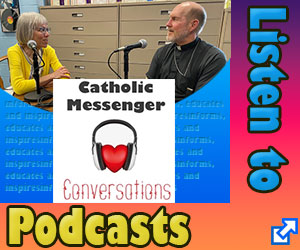By Frank Wessling
Life tomorrow will be much as it is today. Some things will be different, but the fundamentals and the patterns that now make up our rhythm of life will go on.
That’s our normal, natural way of thinking. If the world weren’t basically predictable it would be chaos, and the first principle of faith is that chaos was defeated by God, making life good for us. So, except for a little creativity and opening to change on the margins, we go on expecting a repeat of today tomorrow.
This isn’t going to happen in the Catholic Church, though.
Our children and grandchildren won’t know a church in which priests are common. They may read of a time when parishes had two or three priests, but that will seem like fantasy. And if they don’t live in a population center, it will be hard to find a priest-led Catholic community.
When big change happens suddenly, we call it a crisis. When the change creeps in slowly, nibbling at life in small bites, we may be irritated, as with a few ants at a picnic, but the disruption isn’t worth the energy required for moving to a different place. We have a crisis of Catholic priesthood but act as if our current picnic will go on forever.
In order for Catholic life in this country to continue as it is, we need at least twice as many ordinations to the priesthood as expected. No one has a magical or miraculous source of more seminarians, so the conclusion is clear: Catholic life cannot go on as it is.
It’s not completely true to imply that nothing has been done in expectation of this change. A movement to train lay women and men for ministry has grown up in the church almost in tandem with the decline in priestly ordinations. But as good as this is for the work of maintaining services and fellowship that make a vital community, it doesn’t substitute for the Catholic priesthood.
The priest can be and usually is part organizer, part counselor, part manager, part all of those things lay people can take over – and may well do better than any particular priest. But there is no taking over the symbolic place of the priest.
Without priesthood, without a solemn laying on of hands, there is no person among us who by mere presence is a reminder and call to die as Jesus did. This doesn’t mean the imaginary orgy of blood suggested in Mel Gibson’s movie “The Passion of Christ.” Rather, the priest is a sign of giving everything to faith, subordinating everything in human life to the pattern laid out in the Gospel.
The Gospel is the good news that what we have now is nothing compared to what can be when we abandon self-possession. The gift of self offered in marriage is another sign of how life ultimately is found in transcendence. The priest is a clearer symbol that this message is the whole community’s inner logic.
The priest in his presence says to everyone, as St. Paul does: to live in Christ is to die with Christ. How that might be for each of us is our own particular work of discernment.
It requires priesthood, though, to keep the call and the work always before us. No one else can preside at the re-collection of Christ’s body and blood, his living and dying for us at the altar where we remember what we are.
When we pray that vocations to the priesthood be recognized and brought forward in the church we are praying for our own future blessedness. The people who take on that role won’t be perfect. They will be stumbling sinners from the common mold, something like Peter of the Gospel. We expect nobility from them, but carried out with the humility of servants.
They have the essential task in forming and sustaining the people of God. Anyone thinking about priesthood should understand this and be motivated by it. Our future depends on it.








